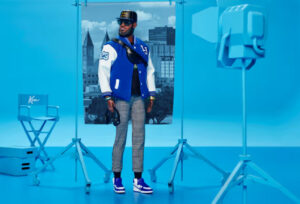In the pantheon of sportswear, few icons carry the gravitas of the Air Jordan. From its inception in 1985 with the Air Jordan 1—banned by the NBA, mythologized by Nike, and immortalized by Michael Jordan himself—the Air Jordan signature line has long represented the intersection of sport, style, and subculture. Forty years later, Jordan Brand celebrates this legacy with the unveiling of the Air Jordan 40, a model that serves not only as a milestone, but also a reflection of how far shoe design, marketing, and storytelling have evolved.
A Legacy in Forty Steps: From 1985 to 2025
The Air Jordan line began at a time when athletic shoes were still primarily utilitarian—performance-oriented and largely unremarkable in their aesthetic design. That changed in 1985, when Nike launched the Air Jordan 1, designed by Peter Moore. Its bold red and black colorway broke the NBA’s uniform rules and marked the birth of an entirely new marketing philosophy—one that turned athletes into brands and sneakers into artifacts.
In the decades that followed, each Jordan release functioned as both a technical upgrade and a cultural moment. The Air Jordan III introduced visible Air and cemented the Jumpman logo. The Air Jordan XI brought patent leather to the court. The XX3 was praised for its sustainability and design elegance, while the XXXIII introduced laceless FastFit technology. Across these iterations, the shoes became narrative devices, each telling a story about Jordan, the brand, and the evolution of footwear culture itself.
Design DNA: What the Air Jordan 40 Says Without Words
The Air Jordan 40, revealed at a media event in New York City attended by shoe outlet Sole Retriever, is the capstone of this multi-decade evolution. Seen in three colorways—including The Classic, Blue Suede, and the focus of this article, Dusty Rose—the model builds on familiar Jordan motifs while experimenting with a more modern palette and luxurious material treatments.
The Dusty Rose colorway trades the standard leather and suede textures for a mix of patent and pebbled leather, creating a dual-texture visual experience. A tonal pink dominates the toe box and midfoot, exuding a sleek, almost formal sheen. This is counterbalanced by the matte pebbled leather on the vamp, eyestays, collar, and heel, rendered in a more muted rose that nods to the subdued pinks of contemporary streetwear.
The black Jumpman logo and lace set offer sharp contrast, anchoring the design and referencing the OG Chicago color scheme’s structural balance. It’s not just pretty—it’s architectural. The silhouette itself is chunky yet streamlined, suggesting performance tech beneath haute surface.
The Air Jordan 40 is as much about visual storytelling as it is about wearable design. It says: this is a shoe that knows where it came from, but isn’t afraid to dress for the now.
Material Metaphors: Patent Leather and Pebbled Rebellion
The choice to blend patent and pebbled leather isn’t just aesthetic—it’s symbolic. Patent leather in shoe design has long signified opulence, first popularized on the Jordan XI, where it mimicked formalwear and elevated basketball footwear into gala-ready fashion. On the Jordan 40, this continues, with a tonal pink glimmer that recalls high fashion runways just as easily as it does hardwood floors.
Pebbled leather, by contrast, is traditionally seen in luxury handbags or refined boots. By using it on performance footwear, the Jordan 40 destabilizes those old hierarchies. This is streetwear haute: tough, supple, and unapologetically unisex. In Dusty Rose, the message is loud and clear—gender is fluid, but taste is permanent.
Why Pink? A Color and a Cultural Reclamation
The Dusty Rose colorway is significant not just for its material richness, but for its emotional resonance. In shoe culture—a space that for decades skewed heavily male—pink was once taboo. It was rare to see a pink sneaker celebrated outside of niche collaborations or “women’s only” drops.
In the last five years, however, color norms have collapsed. Brands like Nike, New Balance, and adidas have increasingly leaned into blush tones, lavender palettes, and pastel ranges. Travis Scott wore dusty pinks. Billie Eilish dropped pale green Jordans. Dusty Rose belongs to this lineage, but offers something slightly more refined: a version of pink that isn’t playful, but commanding. This is not infantilized femininity—it’s tonal assertiveness.
The Jordan 40 as Artifact: Collectability and Commemoration
Sneakerheads often ask the question: “Is this a performance shoe or a collector’s piece?” The Air Jordan 40 is both. Its commemorative status—forty years since the first model—imbues it with instant historical weight. It’s the kind of sneaker that will be archived in museum retrospectives, photographed for sneaker coffee table books, and featured in retrospectives long after the original laces fray.
Yet, for all its iconography, the Jordan 40 is built for real wear. Underfoot cushioning, ankle support, and traction technology make it more than just eye candy. The best Jordans have always balanced performance and prestige—Dusty Rose walks this line with grace.
Public Reception and Media Coverage
Initial public reactions have ranged from reverent to ecstatic. Sneaker forums lit up with early leaks; TikTok influencers praised the silhouette’s balance between retro callbacks and contemporary freshness. YouTube reviews from trusted voices like Jacques Slade and WearTesters applauded the Dusty Rose colorway for its boldness and wearability.
At the NYC media launch, collectors lined up just to touch a pair. With three colorways previewed—each telling a different design story—the Dusty Rose seems poised to be the most wearable, and perhaps most influential, of the trio.
Forty Down, Forever to Go: The Jordan Line Continues
The Jordan 40 closes a generational arc and opens a new chapter. In some ways, it is a time capsule: a design that consolidates four decades of shoe evolution. But in others, it is a preview—a glimpse into the future of Jordan Brand. One where storytelling, premium materials, and cultural adaptability are more important than raw performance specs.
What began with rebellion in 1985 is now an empire. The Air Jordan 40 doesn’t just celebrate that—it quietly sets the tone for what comes next.
No comments yet.







